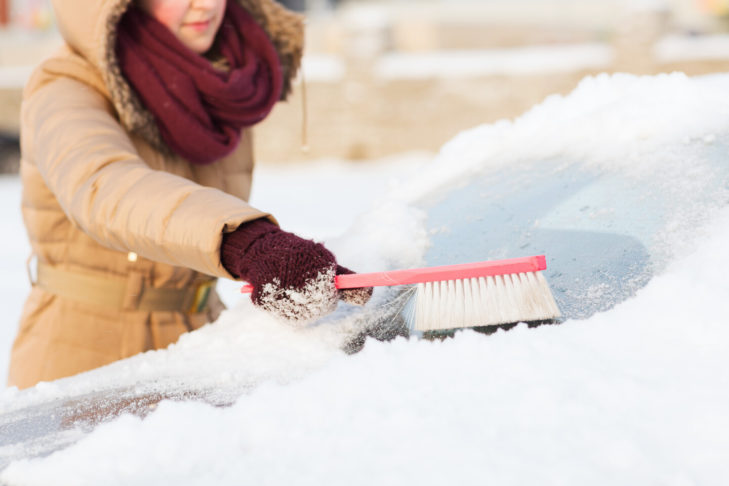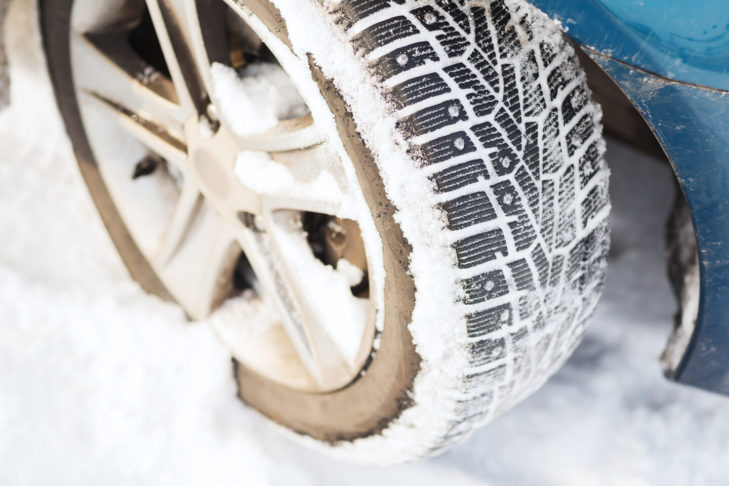When it comes to getting around, the car is the first choice for many winter travellers when going on a ski holiday. To ensure that driving in the snow is safe, SnowTrex provides valuable tips on how to winter-proof your car and what you should bear in mind when driving in winter.
Check winter tyres
Your car should have winter tyres fitted by the time the first snow falls at the latest, and preferably before: winter tyres are recommended between October and Easter. In Austria and Italy, they are even mandatory. Drivers who drive on summer tyres in snowy and icy conditions are not only putting themselves at great risk, but also all other road users. Apart from that, insurance companies will not cover you if it is clear that winter tyres could have prevented an accident.
With winter tyres, it is important that the tread has the required depth. The regulations in the different countries can vary considerably. Anyone going on a ski holiday to Austria, for example, must be travelling with tyres that have a tread depth of at least four millimetres. However, this tread depth is also recommended regardless of the country.
Windscreen wipers, lights, battery & such
In addition to the tyres, there are a few more components and materials on the car that should be checked before the onset of winter. For example: impeccable windscreen wipers. Under no circumstances should they be cracked or leave streaks, as this greatly increases the risk of an accident due to poor visibility. It is also important to ensure that your front fog lights work. They help to improve visibility in heavy snowfall. The same applies to rear fog lights, which are helpful for vehicles behind you, but may only be switched on when visibility is less than 50 metres. Other questions that every driver should ask themselves: Are the headlights clean? Is there enough antifreeze in the windscreen washer system and in the coolant tank? Are the oil level and battery in order? Am I prepared for an emergency – with a jumper cable, a first-aid kit and a warning triangle? And are all the other winter “accessories” on board, such as snow chains, anti-freeze spray for the gaskets and an ice scraper?
Always clear the car
It is dangerous and expensive in the event of an accident if you do not clear the windscreen of ice before setting off. You should always scrape off large areas. A small viewing hole is not enough to have a clear view of the traffic. In addition to the windscreen, the roof, lights and number plate should also be cleared of snow and ice. Even if it speeds up the scraping: In many countries, having the engine idle to switch on the heating is forbidden.
Pack the car correctly
Especially in winter when it’s snowy and icy, you need to make sure that your car or rental car is properly packed for your ski holiday. Bulky items such as skis, snowboards and boots should not simply be carelessly placed in the car, perhaps on top of everything else. It is advisable to stow heavy items in the boot as far forward and at the bottom as possible. Drivers should also make sure that accident and emergency items such as a warning triangle, first aid kit, safety waistcoat and snow chains remain within easy reach. Especially for families with children, the boot is often not big enough for the luggage on a ski holiday. A roof box is therefore worth considering, as it can be used to transport light items of luggage in particular, secured with tensioning straps.
Adapt your driving style
Especially when the roads are snow-covered or slippery, you should slow down considerably and increase the distance to the vehicle in front of you. In such conditions, not only does your car react differently to steering movements, the braking distance is also much longer. It is also advisable to engage a higher gear than usual as quickly as possible in snow and slush. Driving at low revs produces less torque at the wheels, which increases grip on the surface and prevents the wheels from spinning so quickly. To prevent wheel spin, you should also be particularly careful when starting off by letting the clutch come in very slowly and only accelerating slightly, if possible in second gear.
If the road is as smooth as glass, there’s only one thing to do: don’t start driving. If you’re already on the road, it’s best to stand at the side of the road where you can see it clearly and wait until the gritting/salting service has gone by.
Vignette
Before you set off on your ski holiday, you should find out about the vignette requirement in the country you are visiting. In Switzerland and Austria, for example, the vignette is compulsory on federal roads and motorways. The vignette must be clearly visible on the windscreen of the car. Since 2018, it has also been possible to buy a digital vignette that is linked to your number plate. This “sticker” can be purchased any any time via the website or app and saves you the effort of having to affix and scrape it off the windscreen.
Interview with an expert
As part of its research, SnowTrex spoke to Martin Schork, Head of e-commerce at the company Schork, and asked him a few questions about winter driving. Mr Schork is an absolute expert when it comes to car accessories and road safety and shared exciting information and valuable tips on winter driving with SnowTrex.
Which car accessories should not be missing on any winter journey?
We strongly recommend carrying snow chains. Depending on the route you are travelling, snow chains may be mandatory and signs will indicate that they are compulsory. However, there is only a legal obligation to use them if there are appropriate signs. In Austria and Italy in particular, there are expensive penalties for non-compliance. You should also carry hand brushes to remove snow from the vehicle, anti-mist cloths, ice scrapers, de-icer sprays for door locks and rubber polish for the gaskets. Radiator antifreeze and windscreen antifreeze should be filled into the appropriate tanks before you set off so that you are safe on the road even in frosty conditions.
What should be checked in the car before travelling to the mountains?
The air pressure in the tyres should definitely be checked before the journey. There are different recommendations depending on the load of the vehicle; these can be found on the inside of the tank lid, in the handbook or on the B-pillar with the driver’s door open. You should also make sure that the brake fluid and engine oil tanks and the radiator antifreeze and windscreen antifreeze tanks mentioned above are full.
What needs to be considered when fitting roof boxes? What do you need to bear in mind when packing the car and especially when packing the roof box?
The roof box may only be fitted to the vehicle using vehicle-specific products. These depend on whether the car has an open railing, an integrated railing, fixed points or a normal roof, for example. The various manufacturers offer buyer’s guides to help you identify the right items. A classic system often consists of a base set, the appropriate mounting kit and crossbars to which the roof box is attached with claws.
The roof box should then be loaded evenly, not exceeding the maximum payload. Finally, the load must be secured with straps to prevent it from slipping. In the boot, please ensure that there is a clear view through the rear window and that there are no loose objects on top, as these can become a dangerous projectile in the event of an accident.
Is there a recommended maximum speed with a roof box?
The recommended maximum speed when driving with a roof box is 130 km/h.
What differences are there when it comes to snow chains? What is important?
A distinction is made between cable chains, ring chains and quick-fit chains. Cable chains are usually inexpensive, but are more complex to fit. Ring chains are more expensive but easier to fit. As the name suggests, quick-fit chains are the most convenient. They can be fitted very quickly, but a suitable adapter is required. These chains can be easy on the nerves. In general, the thicker the chains, the longer they will last.
What can I do if the door lock is iced up?
If the door lock is iced up, it is worth using door lock de-icer. Ingredients such as isopropyl alcohol, ethanol or glycol ensure that the ice melts.
What should I bear in mind when scraping ice? Which ice scrapers are recommended?
Plastic scrapers are recommended as they are gentle on the windscreen. Brass scrapers are more effective, but can cause light scratches on the windscreen. It is important to de-ice not only the windscreen, but all windows.
If drivers follow these tips, nothing will stand in the way of safe winter driving. Alternatively, you can of course also go on a ski holiday without a car.






